- Search Please fill out this field.
- Manage Your Subscription
- Give a Gift Subscription
- Sweepstakes
- Space Travel + Astronomy

The World's First Space Tourist Arrived at the International Space Station 20 Years Ago — Here's What He Says About the Trip
Dennis Tito, the world's first space tourist, spent eight days at the International Space Station in 2001.
Jessica Poitevien is an international storyteller and regular contributor to Travel + Leisure.
:max_bytes(150000):strip_icc():format(webp)/Jessica-Poitevien-2cbdf969757d480cb8b287cf97d1b882.jpg)
Space tourism once seemed like an idea for the distant future, but with the world's first space hotel set to open in 2027 and companies like SpaceX , Blue Origin, and Virgin Galactic vying to make space travel more broadly available, it seems like the future is now.
And it all started 20 years ago, when U.S. millionaire Dennis Tito became the world's first space tourist .
On April 30, 2001, Tito, then 60, accomplished what was a lifelong dream of his when he arrived at the International Space Station (ISS) on a Russian Soyuz rocket. The trip cost him $20 million, but reflecting on the moment two decades later, Tito still feels the experience was worth every penny.
"The pencils started floating in the air, and I could see the blackness of space and the curvature of the Earth," he told CNN Travel . "I was euphoric. I mean, it was the greatest moment of my life, to achieve a life objective, and I knew then that nothing could ever beat this."
Though Tito was working in finance when he launched into orbit, he had originally started his career in aeronautics and astronautics and kept his dream of going to space alive for several decades, CNN Travel reports. For Tito, outer space was something that had fascinated him since childhood.
According to CNN Travel , NASA was against the idea of sending civilians to space, so in 1991, Tito turned to the Soviet Union and began conversations about paying to join the country's space mission. Later in that decade, he resumed those conversations before his eventual flight in 2001.
"In the late '90s, the Russians were really hurting for funding of this space program and the bottom line was, I figured out, 'Huh, maybe I could get involved with the Russians,'" he told CNN Travel .
Eventually, on April 28, 2001, Tito took off on his journey to the ISS with two Russian cosmonauts by his side. They arrived at the station two days later.
"I just enjoyed looking at the window, videoing the Earth, the portholes, the station. It was just wonderful," Tito told CNN Travel . "It just was — whatever I had expected, the best I had expected times 10. It was the best experience of my whole life, those eight days."
Though only a handful of other ultra-wealthy people have managed to pay their way onto a space mission since Tito first paved the way, he is keeping an eye on the industry's development, hoping more people will get to experience what he did.
"I just wish them the best," he said to CNN Travel . "I am hopeful they will have the wonderful experience that I had."
Jessica Poitevien is a Travel + Leisure contributor currently based in South Florida, but she's always on the lookout for her next adventure. Besides traveling, she loves baking, talking to strangers, and taking long walks on the beach. Follow her adventures on Instagram .
Leisure travel might be a little more exciting for the world’s wealthiest adventure seekers as space, long the exclusive domain of professional astronauts, is now accessible to tourists. In July 2021, Virgin Galactic and Blue Origin each successfully launched suborbital tourism programs from their spaceports in New Mexico and Texas, respectively (with Blue Origin completing its second launch in October 2021). In September 2021, SpaceX’s Inspiration4 mission kicked off the company’s orbital tourism program from the Kennedy Space Center’s historic Launch Complex 39A. Each of these companies hope to make space a popular destination by offering regular launch services to private citizens. Aspiring space tourists can expect to pay upwards of $250,000 for a seat on suborbital spacecrafts and an estimated $50 million for a ticket to orbit. Space enthusiasts on a budget can tour Spaceport America, where Virgin Galactic launches to space, for $50 or less.
These historic spaceflights represent the most recent chapter in a longer history of space tourism. More than 20 years ago, Dennis Tito, the first “space tourist” (also known as “spaceflight participant”), flew to the International Space Station aboard a Soyuz spacecraft for a six-day stay. Tito donated the Sokol pressure suit he wore in space to the Museum in 2003. Since his flight, only six other individuals scored self-funded travel to space (one of these intrepid travelers flew twice). Space Adventures, a US-based travel agency to the stars, facilitated these multi-million dollar, out-of-this-world experiences in partnership with the Russian space agency, Roscosmos.
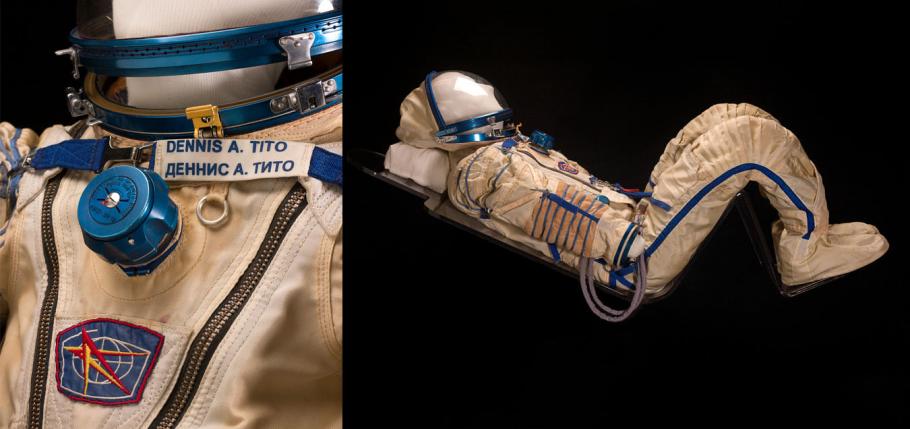
Dennis Tito wore this suit when he launched to the International Space Station on April 28, 2001. (Smithsonian Institution)
Although space itself remained inaccessible to private citizens until the 21st century, other places where Earth and space meet—such as National Aeronautics and Space Administration (NASA) centers—have long been popular destinations for a different kind of space tourist.
The Space Age dawned in the golden age of the family road trip. Thanks to the proliferation of private automobile ownership, an expanding interstate highway system, and the advent of more generous vacation policies in the workplace, Americans ventured from home in greater numbers in the 1960s than at any earlier time in the nation’s history. Millions of these travelers included on their itineraries NASA centers, particularly those with ties to the human spaceflight program: the George C. Marshall Space Flight Center in Huntsville, Alabama; the John F. Kennedy Space Center in Brevard County, Florida; and the Manned Spacecraft Center (known since 1973 as the Johnson Space Center) in Houston, Texas.
NASA centers were not prepared for the tourists who appeared en masse outside their gates. In the early 1960s, the centers operated much like—and were often physically adjacent to—secure military installations. For reasons of national security, the centers restricted access to official visitors only. In response to curious onlookers, the centers developed ad hoc visitor programs. At the same time, proactive civic leaders and enterprising business-people responded to the presence of space center tourists by developing their own space-themed attractions, including museums, halls of fame, and amusement parks, and amenities, such as motels, hotels, and restaurants.
At the Kennedy Space Center, for example, public affairs officers facilitated increasing access to NASA’s launch complex between 1964 and 1967. Their efforts began while the spaceport was under construction with a modest roadside trailer featuring wall-mounted exhibitions. They soon expanded visitor programming to include self-guided driving tours on weekends and holidays during breaks in construction activity. In 1966, the space center partnered with Trans World Airlines (TWA) to operate an escorted bus tour program.

Trans World Airlines (TWA) operated the bus tour program at the Kennedy Space Center in the 1960s. (NASA/KSC Spaceport News)
The following year, the Visitor Information Center opened to the public. It featured indoor exhibition and presentation facilities, an outdoor “rocket garden” that became a popular backdrop for family photos, and a depot for the bus tour program. The architect included all the amenities a traveler might need, such as restrooms, food concessions, a gift shop, and a pay phone, which is now on display at our Steven F. Udvar-Hazy Center. Shaped like a Mercury capsule, the pay phone was painted in a playful tropical teal color, which was en vogue at other Florida attractions at the time. Since 1967, the Visitor Information Center has continued to evolve and expand, reflecting developments in spaceflight and the evolving expectations of 21st century vacationers. Some 1.5 million people visit annually.
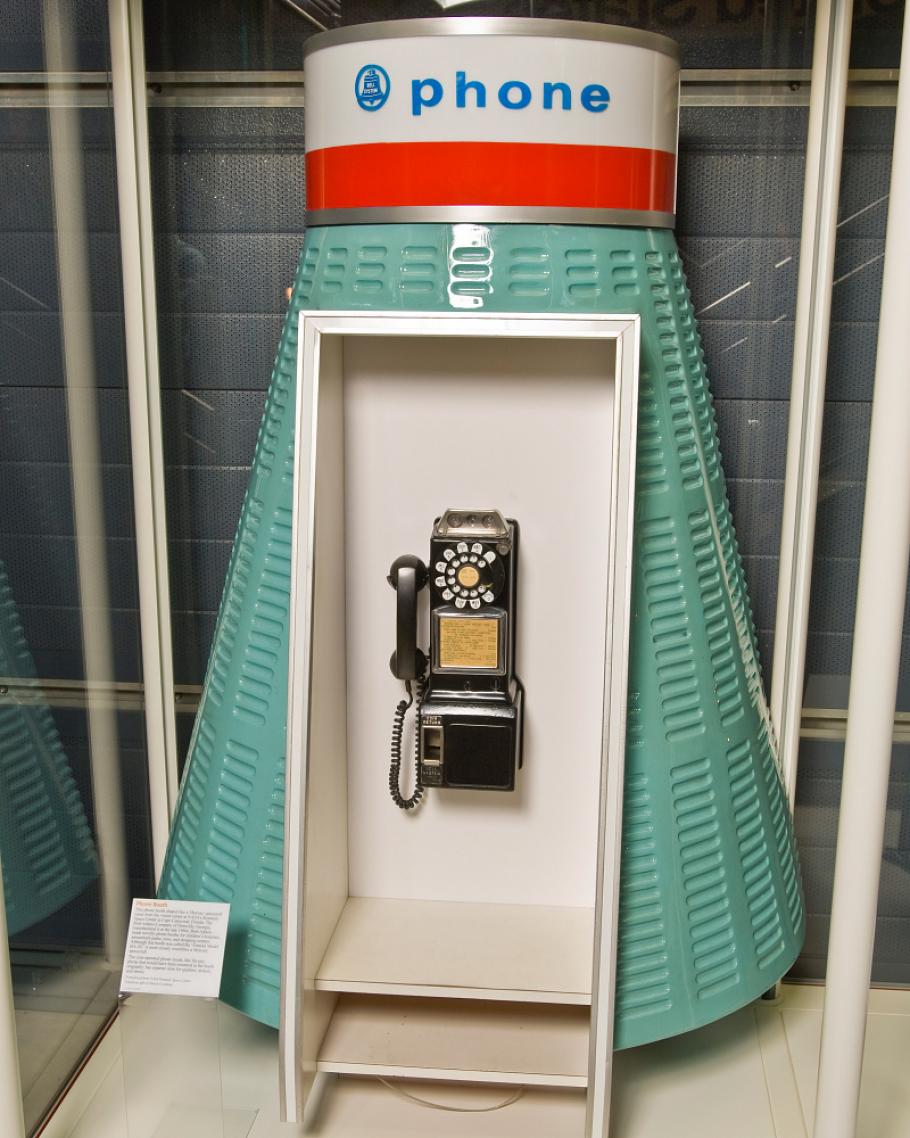
This phonebooth was installed at the Visitor Information Center at NASA’s Kennedy Space Center during the 1960s. (Smithsonian Institution)
Whether venturing to space, visiting a spaceport, or engaging in space-related recreation, individuals and families are likely to continue the tradition of incorporating space activities as part of their leisure time. As we enter the next chapter in the history of space tourism, questions about the significance of these experiences endure: What do “space tourists” hope to gain from their encounter with space or space sites? What does their choice of vacation destination say about their individual identities and the cultural significance of space? Who has access to these experiences and who is left out? And how will space tourism reshape communities on Earth as the industry evolves?
We rely on the generous support of donors, sponsors, members, and other benefactors to share the history and impact of aviation and spaceflight, educate the public, and inspire future generations. With your help, we can continue to preserve and safeguard the world’s most comprehensive collection of artifacts representing the great achievements of flight and space exploration.
- Get Involved
- Host an Event
Thank you. You have successfully signed up for our newsletter.
Error message, sorry, there was a problem. please ensure your details are valid and try again..
- Free Timed-Entry Passes Required
- Terms of Use

Space tourism, 20 years in the making, is finally ready for launch
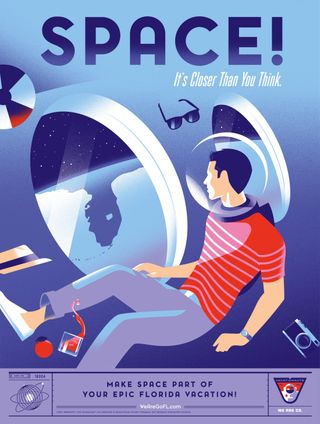
This article was originally published at The Conversation. The publication contributed the article to Space.com's Expert Voices: Op-Ed & Insights .
For most people, getting to the stars is nothing more than a dream. On April 28, 2001, Dennis Tito achieved that lifelong goal — but he wasn't a typical astronaut. Tito, a wealthy businessman, paid US$20 million for a seat on a Russian Soyuz spacecraft to be the first tourist to visit the International Space Station. Only seven people have followed suit in the 20 years since, but that number is poised to double in the next 12 months alone.
NASA has long been hesitant to play host to space tourists , so Russia — looking for sources of money post-Cold War in the 1990s and 2000s — has been the only option available for those looking for this kind of extreme adventure. However, it seems the rise of private space companies is going to make it easier for regular people to experience space.
From my perspective as a space policy analyst , I see the beginning of an era in which more people can experience space. With companies like SpaceX and Blue Origin hoping to build a future for humanity in space, space tourism is a way to demonstrate both the safety and reliability of space travel to the general public.
Related: Virgin Galactic says it will launch Richard Branson to space on July 11

The development of space tourism
Flights to space like Dennis Tito's are expensive for a reason. A rocket must burn a lot of costly fuel to travel high and fast enough to enter Earth's orbit.
Another cheaper possibility is a suborbital launch, with the rocket going high enough to reach the edge of space and coming right back down. While passengers on a suborbital trip experience weightlessness and incredible views, these launches are more accessible.
Get the Space.com Newsletter
Breaking space news, the latest updates on rocket launches, skywatching events and more!
The difficulty and expense of either option has meant that, traditionally, only nation-states have been able to explore space. This began to change in the 1990s as a series of entrepreneurs entered the space arena. Three companies led by billionaire CEOs have emerged as the major players: Virgin Galactic, Blue Origin and SpaceX. Though none have taken paying, private customers to space, all anticipate doing so in the very near future.
British billionaire Richard Branson has built his brand on not just business but also his love of adventure. In pursuing space tourism, Branson has brought both of those to bear. He established Virgin Galactic after buying SpaceShipOne - a company that won the Ansari X-Prize by building the first reusable spaceship. Since then, Virgin Galactic has sought to design, build and fly a larger SpaceShipTwo that can carry up to six passengers in a suborbital flight.
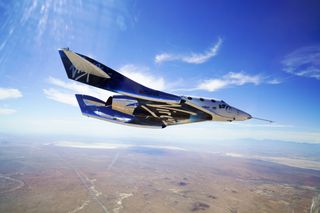
The going has been harder than anticipated. While Branson predicted opening the business to tourists in 2009, Virgin Galactic has encountered some significant hurdles — including the death of a pilot in a crash in 2014 . After the crash, engineers found significant problems with the design of the vehicle, which required modifications.
Elon Musk and Jeff Bezos, respective leaders of SpaceX and Blue Origin, began their own ventures in the early 2000s.
Musk, fearing that a catastrophe of some sort could leave Earth uninhabitable, was frustrated at the lack of progress in making humanity a multiplanetary species. He founded SpaceX in 2002 with the goal of first developing reusable launch technology to decrease the cost of getting to space. Since then, SpaceX has found success with its Falcon 9 rocket and Dragon spacecraft. SpaceX's ultimate goal is human settlement of Mars — sending paying customers to space is an intermediate step. Musk says he hopes to show that space travel can be done easily and that tourism might provide a revenue stream to support development of the larger, Mars-focused Starship system.
Bezos, inspired by the vision of physicist Gerard O'Neill , wants to expand humanity and industry not to Mars, but to space itself. Blue Origin , established in 2004, has proceeded slowly and quietly in also developing reusable rockets. Its New Shepard rocket, first successfully flown in 2015, will eventually offer tourists a suborbital trip to the edge of space, similar to Virgin Galactic's. For Bezos, these launches represent an effort at making space travel routine, reliable and accessible to people as a first step to enabling further space exploration.

Outlook for the future
Now, SpaceX is the only option for someone looking to go into space and orbit the Earth. It currently has two tourist launches planned. The first is scheduled for as early as September 2021 , funded by billionaire businessman Jared Isaacman. The other trip, planned for 2022, is being organized by Axiom Space . These trips will be costly , at $55 million for the flight and a stay on the International Space Station. The high cost has led some to warn that space tourism — and private access to space more broadly — might reinforce inequality between rich and poor.
Blue Origin's and Virgin Galactic's suborbital trips are far more reasonable in cost, with both priced between $200,000 and $250,000 . Blue Origin appears to be the nearest to allowing paying customers on board, saying after a recent launch that crewed missions would be happening "soon." Virgin Galactic continues to test SpaceShipTwo, but no specific timetable has been announced for tourist flights.
Though these prices are high, it is worth considering that Dennis Tito's $20 million ticket in 2001 could pay for 100 flights on Blue Origin soon. The experience of viewing the Earth from space, though, may prove to be priceless for a whole new generation of space explorers.
This article is republished from The Conversation under a Creative Commons license. Read the original article .
Follow all of the Expert Voices issues and debates — and become part of the discussion — on Facebook and Twitter. The views expressed are those of the author and do not necessarily reflect the views of the publisher.
Join our Space Forums to keep talking space on the latest missions, night sky and more! And if you have a news tip, correction or comment, let us know at: [email protected].

I received a BA in political science (summa cum laude and university honors) and an MA in political science from the University of Central Florida. I received a Ph.D. in political science from the University of Florida where my research focused on the intersection of political institutions and public policy. I have authored several books including Unbroken Government: Success and Failure in Policymaking (Palgrave Macmillan, 2013), The Politics of Cancer: Malignant Indifference (Praeger, 2017), and The CQ Press Career Guide for Political Science Students (CQ Press, 2017). My research has also appeared in journals including Congress and the Presidency, Space Policy, and the Journal of Political Science Education. I am currently professor of strategy and security studies at the US Air Force's School of Advanced Air and Space Studies, a selective graduate program for Air Force officers. Prior to my current position, I was associate professor of political science at Cameron University in Lawton, Oklahoma.
SpaceX launching Falcon 9 rocket on record-tying 20th mission today
Boeing's Starliner spacecraft is 'go' for May 6 astronaut launch
Russia vetoes UN resolution against nuclear weapons in space
Most Popular
- 2 Beavers are helping fight climate change, satellite data shows
- 3 Astronomers just discovered a comet that could be brighter than most stars when we see it next year. Or will it?
- 4 This Week In Space podcast: Episode 108 — Starliner: Better Late Than Never?
- 5 Boeing's Starliner spacecraft will not fly private missions yet, officials say
The World’s First Space Tourist Plans a Return Trip—This Time to the Moon
F ew people had heard of aerospace engineer and financial analyst Dennis Tito before 2001. That was the year Tito, then 60, became the first paying space tourist, cutting a $20 million check to Russia to fly aboard a Soyuz spacecraft and spend a week aboard the International Space Station (ISS). Since then, Tito has remained Earthbound, but has never quite shaken the adventuring bug. Now, he is planning to return to space—this time traveling to the moon, a route nobody but the Apollo astronauts have ever flown.
As SpaceNews , CNN , and others report, Tito, now 82, and his wife Akiko, have both inked a deal to travel on a one-week journey aboard SpaceX’s Starship spacecraft, along with up to 10 other paying passengers. They will be flying a path that will take them around the far side of the moon and slingshot them back home. The amount Tito and his wife are paying for their seats aboard the ship has not been disclosed.
The Starship is a 50 m (164 ft.) tall stainless steel spacecraft that launches atop SpaceX’s 69 m (226 ft.) Super Heavy booster. While the the rocket has never flown before, SpaceX hopes to launch it on its first, uncrewed Earth-orbital mission as early as next month. Following that, the Starship-Super Heavy pair will make its first crewed flight—also Earth orbital—in 2024 or 2025. Tito’s circumlunar flight would come sometime after that.
Just this week, SpaceX rolled the Super Heavy booster out to the launch pad at its Boca Chica, Texas, launch base, and stacked the Starship spacecraft on top. It was the first time the two segments of the giant machine had been mated. Together they make a formidable sight, towering 120 m (394 ft.) high—or a good seven stories taller than NASA’s mega moon rocket , the Space Launch System (SLS). Starship is also significantly more powerful than the SLS. Starship’s 33, methane-fueled engines put out 7.2 million kg (16 million lb.) of thrust, nearly double that of NASA’s 6-engine rocket, which produces 4 million kg (8.8 million lb.).
Tito will make his journey aboard an identical machine—indeed, it could be the exact same one, since both the Starship and Super Heavy are designed to be reusable. In some respects, he surprised himself by deciding to make the trip at all. Until recently, he said in a call with reporter, he had hadn’t been planning to return to space, but, “over time, watching the developments of SpaceX and just what they were doing fascinated me.”
Last year, he began discussions with SpaceX, and told the company he would like to fly again, though not merely to the ISS. “‘I would be interested in going to the moon,'” he recalls saying. “And then I looked over to Akiko, and we had a little eye contact, and she goes, ‘Yeah, me too.’”
For the record, Tito says that after this mission, he really, truly will be retiring from the spaceflight game.
More Must-Reads From TIME
- The 100 Most Influential People of 2024
- Coco Gauff Is Playing for Herself Now
- Scenes From Pro-Palestinian Encampments Across U.S. Universities
- 6 Compliments That Land Every Time
- If You're Dating Right Now , You're Brave: Column
- The AI That Could Heal a Divided Internet
- Fallout Is a Brilliant Model for the Future of Video Game Adaptations
- Want Weekly Recs on What to Watch, Read, and More? Sign Up for Worth Your Time
Write to Jeffrey Kluger at [email protected]
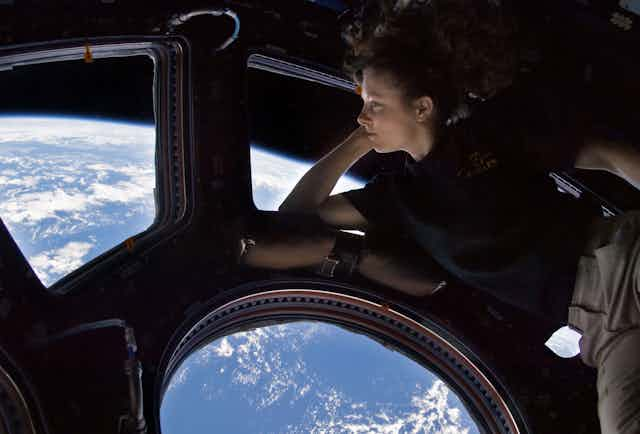
Space tourism is here – 20 years after the first stellar tourist, Jeff Bezos’ Blue Origin plans to send civilians to space
Professor of Strategy and Security Studies, Air University
Disclosure statement
Wendy Whitman Cobb is affiliated with the US Air Force School of Advanced Air and Space Studies. Her views are her own and do not necessarily reflect the views of the Defense Department or any of its affiliates.
View all partners
For most people, getting to the stars is nothing more than a dream. But on May 5, 2021, the 60th anniversary of the first suborbital flight, that dream became a little bit more achievable.
The space company Blue Origin announced that it would start selling tickets for suborbital flights to the edge of space . The first flight is scheduled for July 20, and Jeff Bezos’ company is auctioning off one single ticket to the highest bidder .
But whoever places the winning bid won’t be the first tourist in space.
On April 28, 2001, Dennis Tito, a wealthy businessman, paid US$20 million for a seat on a Russian Soyuz spacecraft to be the first tourist to visit the International Space Station. Only seven civilians have followed suit in the 20 years since, but that number is poised to double in the next 12 months alone.
NASA has long been hesitant to play host to space tourists , so Russia – looking for sources of money post-Cold War in the 1990s and 2000s – has been the only option available to those looking for this kind of extreme adventure. However, it seems the rise of private space companies is going to make it easier for regular people to experience space.
From my perspective as a space policy analyst , recent announcements from companies like Blue Origin and SpaceX are the opening of an era in which more people can experience space. Hoping to build a future for humanity in space, these companies are seeking to use space tourism as a way to demonstrate both the safety and reliability of space travel to the general public.
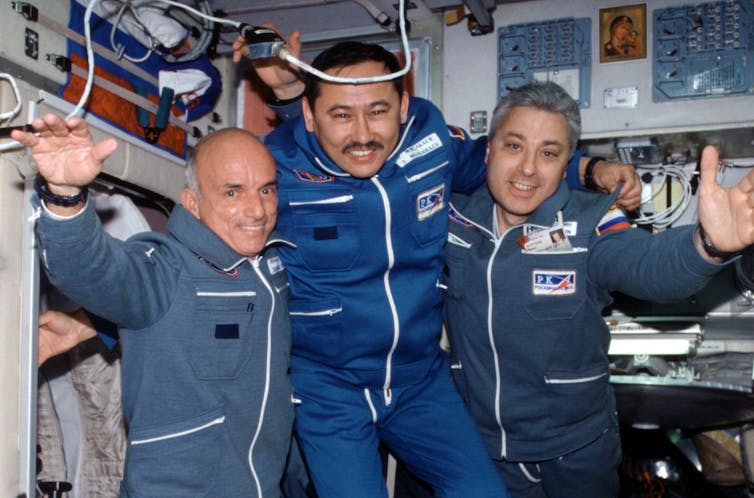
The development of space tourism
Flights to space like Dennis Tito’s are expensive for a reason. A rocket must burn a lot of costly fuel to travel high and fast enough to enter Earth’s orbit.
Another cheaper possibility is a suborbital launch, with the rocket going high enough to reach the edge of space and coming right back down. This is the kind of flight that Blue Origin is now offering. While passengers on a suborbital trip experience weightlessness and incredible views, these launches are more accessible.
The difficulty and expense of either option has meant that, traditionally, only nation-states have been able to explore space. This began to change in the 1990s as a series of entrepreneurs entered the space arena. Three companies led by billionaire CEOs have emerged as the major players: Blue Origin, SpaceX and Virgin Galactic. Though none have taken paying, private customers to space, all anticipate doing so in the very near future.
British billionaire Richard Branson has built his brand on not just business but also his love of adventure. In pursuing space tourism, Branson has brought both of those to bear. He established Virgin Galactic after buying SpaceShipOne – a company that won the Ansari X-Prize by building the first reusable spaceship. Since then, Virgin Galactic has sought to design, build and fly a larger SpaceShipTwo that can carry up to six passengers in a suborbital flight.
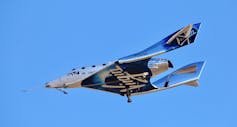
The going has been harder than anticipated. While Branson predicted opening the business to tourists in 2009, Virgin Galactic has encountered some significant hurdles – including the death of a pilot in a crash in 2014 . After the crash, engineers found significant problems with the design of the vehicle, which required modifications.
Elon Musk and Jeff Bezos, respective leaders of SpaceX and Blue Origin, began their own ventures in the early 2000s.
Musk, fearing that a catastrophe of some sort could leave Earth uninhabitable, was frustrated at the lack of progress in making humanity a multiplanetary species. He founded SpaceX in 2002 with the goal of first developing reusable launch technology to decrease the cost of getting to space. Since then, SpaceX has found success with its Falcon 9 rocket and Dragon spacecraft . SpaceX’s ultimate goal is human settlement of Mars; sending paying customers to space is an intermediate step. Musk says he hopes to show that space travel can be done easily and that tourism might provide a revenue stream to support development of the larger, Mars-focused Starship system.
Bezos, inspired by the vision of physicist Gerard O’Neill , wants to expand humanity and industry not to Mars but to space itself. Blue Origin , established in 2004, has proceeded slowly and quietly in also developing reusable rockets. Its New Shepard rocket, first successfully flown in 2015, will be the spaceship taking tourists on suborbital trips to the edge of space this July . For Bezos, these launches represent an effort at making space travel routine, reliable and accessible as a first step to enabling further space exploration.
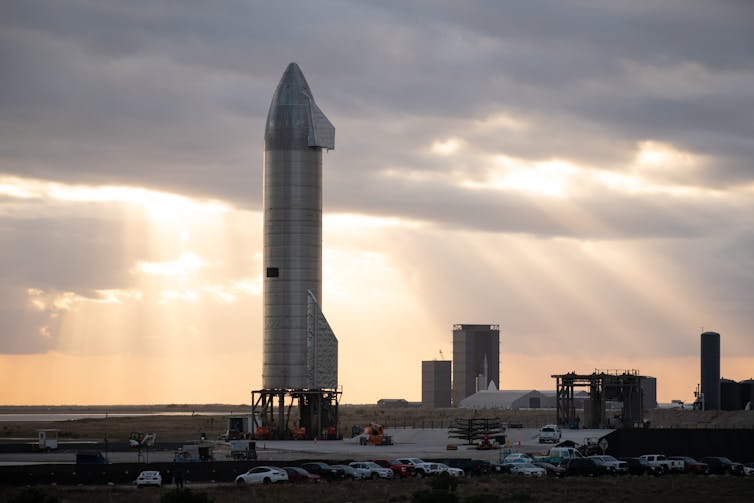
Outlook for the future
Blue Origin is not the only company offering passengers the opportunity to go into space and orbit the Earth.
SpaceX currently has two tourist launches planned. The first is scheduled for as early as September 2021 , funded by billionaire businessman Jared Isaacman. The other trip, planned for 2022, is being organized by Axiom Space . These trips will be costly for wannabe space travelers, at $55 million for the flight and a stay on the International Space Station. The high cost has led some to warn that space tourism – and private access to space more broadly – might reinforce inequality between rich and poor.
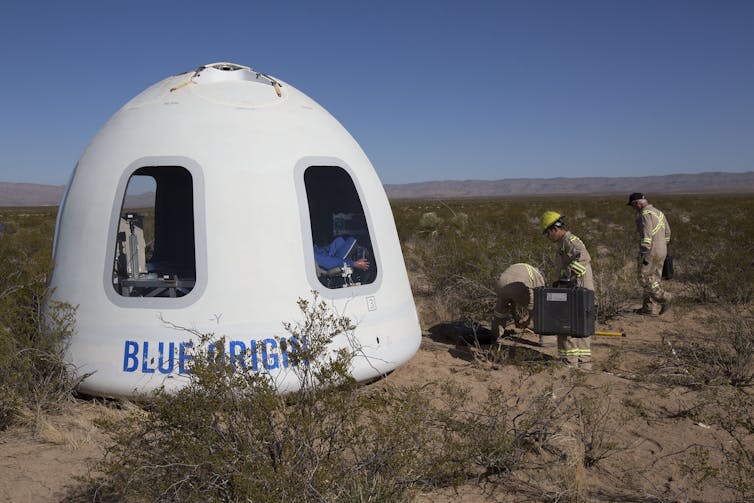
While Blue Origin is already accepting bids for a seat on the first launch, it has not yet announced the cost of a ticket for future trips. Passengers will also need to meet several physical qualifications, including weighing 110 to 223 pounds (50 to 101 kg) and measuring between 5 feet and 6 feet, 4 inches (1.5 to 1.9 meters) in height. Virgin Galactic, which continues to test SpaceShipTwo, has no specific timetable, but its tickets are expected to be priced from $200,000 to $250,000 .
Though these prices are high, it is worth considering that Dennis Tito’s $20 million ticket in 2001 could potentially pay for 100 flights on Blue Origin soon. The experience of viewing the Earth from space, though, may prove to be priceless for a whole new generation of space explorers.
This is an updated version of an article originally published on April 28, 2021. It has been updated to include the announcement by Blue Origin.
- Space tourism
- International Space Station (ISS)
- Virgin Galactic
- Blue Origin
- Suborbital flight

Program Manager, Teaching & Learning Initiatives

Lecturer/Senior Lecturer, Earth System Science (School of Science)

Sydney Horizon Educators (Identified)

Deputy Social Media Producer

Associate Professor, Occupational Therapy
- Election 2024
- Entertainment
- Newsletters
- Photography
- Personal Finance
- AP Investigations
- AP Buyline Personal Finance
- AP Buyline Shopping
- Press Releases
- Israel-Hamas War
- Russia-Ukraine War
- Global elections
- Asia Pacific
- Latin America
- Middle East
- Election Results
- Delegate Tracker
- AP & Elections
- Auto Racing
- 2024 Paris Olympic Games
- Movie reviews
- Book reviews
- Personal finance
- Financial Markets
- Business Highlights
- Financial wellness
- Artificial Intelligence
- Social Media
Virgin Galactic’s first space tourists finally soar, an Olympian and a mother-daughter duo
Virgin Galactic rocketed to the edge of space with its first tourists Thursday, including a former British Olympian who bought his ticket 18 years ago and a mother-daughter duo from the Caribbean. (August 10) (Production Marissa Duhaney)
This photo provided Virgin Galactic shows passengers during Virgin Galactic’s first space tourism flight on Thursday Aug. 10, 2023. Virgin Galactic rocketed to the edge of space with its first tourists Thursday. The space plane glided back to a runway landing at Spaceport America in the New Mexico desert, after a brief flight that gave passengers a few minutes of weightlessness.(Virgin Galactic via AP)
- Copy Link copied
Virgin Galactic’s rocket-powered plane Unity 22, lands after a short flight to the edge of space at Spaceport America, near Truth or Consequences, N.M., Thursday, Aug. 10, 2023. Virgin Galactic is taking its first space tourists on a long-delayed rocket ship ride. (AP Photo/Andrés Leighton)
Virgin Galactic’s rocket-powered plane Unity 22, left, flies past its mothership Eve on its way to the edge of space after taking off from Spaceport America, near Truth or Consequences, N.M., Thursday, Aug. 10, 2023. Virgin Galactic is taking its first space tourists on a long-delayed rocket ship ride. (AP Photo/Andrés Leighton)
Virgin Galactic’s mothership Eve, carrying the rocket-powered plane Unity 22, flies after taking off from Spaceport America, near Truth or Consequences, N.M., Thursday, Aug. 10, 2023. Virgin Galactic is taking its first space tourists on a long-delayed rocket ship ride. (AP Photo/Andrés Leighton)
Space tourists, from left, Anastatia Mayers, Jon Goodwin and Keisha Schahaff pose for photos before boarding their Virgin Galactic flight at Spaceport America, near Truth or Consequences, N.M., Thursday, Aug. 10, 2023. Virgin Galactic is taking its first space tourists on a long-delayed rocket ship ride. (AP Photo/Andrés Leighton)
Guests wave flags of Antigua and Barbuda while watching the return of Virgin Galactic’s rocket-powered plane Unity at Spaceport America, near Truth or Consequences, N.M., Thursday, Aug. 10, 2023. Virgin Galactic is taking its first space tourists on a long-delayed rocket ship ride, including a British former Olympian and a mother-daughter duo from the Caribbean island. (AP Photo/Andrés Leighton)
Space tourists, from left, Anastatia Mayers, Jon Goodwin and Keisha Schahaff walk to the tarmac before boarding their Virgin Galactic flight at Spaceport America, near Truth or Consequences, N.M., Thursday, Aug. 10, 2023. Virgin Galactic is taking its first space tourists on a long-delayed rocket ship ride. (AP Photo/Andrés Leighton)
Virgin Galactic’s mothership Eve, carrying the rocket-powered plane Unity 22, takes off from Spaceport America, near Truth or Consequences, N.M., Thursday, Aug. 10, 2023. Virgin Galactic is taking its first space tourists on a long-delayed rocket ship ride. (AP Photo/Andrés Leighton)
TRUTH OR CONSEQUENCES, N.M. (AP) — Virgin Galactic rocketed to the edge of space with its first tourists Thursday, a former British Olympian who bought his ticket 18 years ago and a mother-daughter duo from the Caribbean.
The space plane glided back to a runway landing at Spaceport America in the New Mexico desert, after a brief flight that gave passengers a few minutes of weightlessness.
This first private customer flight had been delayed for years; its success means Richard Branson’s Virgin Galactic can now start offering monthly rides, joining Jeff Bezos’ Blue Origin and Elon Musk’s SpaceX in the space tourism business.
“That was by far the most awesome thing I’ve ever done in my life,” said Jon Goodwin, who competed in canoeing in the 1972 Olympics.
Goodwin, 80, was among the first to buy a Virgin Galactic ticket in 2005 and feared, after later being diagnosed with Parkinson’s disease, that he’d be out of luck. Since then he’s climbed Mount Kilimanjaro and cycled back down, and said he hopes his spaceflight shows others with Parkinson’s and other illnesses that ”it doesn’t stop you doing things.”
Ticket prices were $200,000 when Goodwin signed up. The cost is now $450,000.
He was joined on the flight by sweepstakes winner Keisha Schahaff, 46, a health coach from Antigua, and her daughter, Anastatia Mayers, 18, a student at Scotland’s University of Aberdeen. They high-fived and pumped their fists as the spaceport crowd cheered their return.
“A childhood dream has come true,” said Schahaff, who took pink Antiguan sand up with her. Added her daughter: “I have no words. The only thought I had the whole time was ‘Wow!’ ”
With the company’s astronaut trainer and one of the two pilots, it marked the first time women outnumbered men on a spaceflight, four to two.
Cheers erupted from families and friends watching below when the craft’s rocket motor fired after it was released from the twin-fuselage aircraft that had carried it aloft. The rocket ship’s portion of the flight lasted about 15 minutes and it reached 55 miles (88 kilometers) high.
It was Virgin Galactic’s seventh trip to space since 2018, but the first with a ticket-holder. Branson, the company’s founder, hopped on board for the first full-size crew ride in 2021. Italian military and government researchers soared in June on the first commercial flight. About 800 people are currently on Virgin Galactic’s waiting list, according to the company.
In contrast to Virgin Galactic’s plane-launched rocket ship, the capsules used by SpaceX and Blue Origin are fully automated and parachute back down.
Like Virgin Galactic, Blue Origin aims for the fringes of space, quick ups-and-downs from West Texas. Blue Origin has launched 31 people so far, but flights are on hold following a rocket crash last fall. The capsule, carrying experiments but no passengers, landed intact.
SpaceX, is the only private company flying customers all the way to orbit, charging a much heftier price, too: tens of millions of dollars per seat. It’s already flown three private crews. NASA is its biggest customer, relying on SpaceX to ferry its astronauts to and from the International Space Station. since 2020.
People have been taking on adventure travel for decades, the risks underscored by the recent implosion of the Titan submersible that killed five passengers on their way down to view the Titanic wreckage. Virgin Galactic suffered its own casualty in 2014 when its rocket plane broke apart during a test flight, killing one pilot. Yet space tourists are still lining up, ever since the first one rocketed into orbit in 2001 with the Russians.
Branson, who lives in the British Virgin Islands, watched Thursday’s flight from a party in Antigua. He was joined by the country’s prime minister, as well as Schahaff’s mother and other relatives.
“Welcome to the club,” he told the new spacefliers via X, formerly Twitter.
Several months ago, Branson held a virtual lottery to establish a pecking order for the company’s first 50 customers — dubbed the Founding Astronauts. Virgin Galactic said the group agreed Goodwin would go first, given his age and his Parkinson’s.
This story has been updated to correct introductory price to $200,000, not $250,000.
Dunn reported from Cape Canaveral, Florida.
The Associated Press Health and Science Department receives support from the Howard Hughes Medical Institute’s Science and Educational Media Group. The AP is solely responsible for all content.
Virgin Galactic sends its first tourist passengers into space
Virgin Galactic launched its first tourist passengers into the weightlessness of space Thursday, the culmination of a nearly two-decade commercial pursuit, the company said.
Issued on: 10/08/2023 - 21:46 Modified: 10/08/2023 - 21:44
The three passengers -- Jon Goodwin, Keisha Schahaff, and her teenage daughter Anastatia Mayers -- floated gravity-free through the Virgin spacecraft about 45 minutes after taking off.
"They are officially astronauts. Welcome to space ," said Virgin Galactic announcer Sirisha Bandla as the spacecraft pushed above 80 kilometers (50 miles) in altitude, the level marking the edge of space where the pull of gravity is minimal.
Live video showed the three admiring views of Earth and space through the windows.
After a few minutes in space, the craft began descending and safely landed in the US state of New Mexico, on the same runway from which it took off.
The flight was "without a doubt the most exciting day of my life", said Goodwin, 80, an adventurer who competed in the 1972 Olympic Games as a canoeist for Britain.
"The pure acceleration, Mach-3 in eight-and-a-half seconds was completely surreal," he said.
"It was incredible and I'm still starstruck," said Mayers, who at 18 became the youngest person ever to go into space, according to the company.
Dream of space tourism
Thursday's long-awaited flight was the culmination of a nearly two-decade-old promise by British billionaire Richard Branson, Virgin Galactic's founder, to bring tourists into space, giving them the chance to experience weightlessness and see Earth from afar.
The spaceflights involve a giant, twin-fuselage carrier aircraft that takes off from a runway, gains altitude, then drops a rocket-powered spaceplane that soars higher.
This mission, named Galactic 02, is the company's second commercial flight.
The first at the end of June carried a group of senior Italian Air Force officers who had carried out several experiments on board, rather than civilians making the trip purely for pleasure.
Founded in 2004, Virgin Galactic has sold around 800 tickets for seats on future commercial flights -- 600 between 2005 and 2014 for $200,000 to $250,000, and 200 since then for $450,000 each.
Goodwin reserved his seat in 2005, only to be struck with Parkinson's Disease nine years later, dampening his hopes.
"I thought that's the end of me going into space," he said.
Instead, he was chosen and passed the physical tests, to become the first paying passenger for the Virgin galactic program.
"It exceeded my wildest dreams," he said.
Schahaff and Mayers won their tickets in a charity raffle organized by Virgin Galactic. .
Schahaff is a 46-year-old health coach from Antigua and Barbuda, while her daughter studies philosophy and physics at the University of Aberdeen in Scotland.
Both said the trip was an amazing experience.
Mayers said the trip "awakened" her.
"I was shocked at the things that you feel, you are so much more connected to everything than you would expect to be," she said.
"I definitely feel a lot more connected to Earth itself, and a lot more motivated to explore and be even more adventurous," she said.
Branson, who made a fortune in the music industry, railways and aviation, watched the flight via video from Antigua and Barbuda, where he joined a crowd with the family of Schahaff and Mayers.
Virgin Galactic competes in the "suborbital" space tourism sector with billionaire Jeff Bezos's company Blue Origin, which has already sent 31 people into space using a vertical lift-off rocket.
But since an accident in September 2022 during an unmanned flight, Blue Origin's rocket has been grounded. The company promised in March to resume spaceflight soon.
Daily newsletter Receive essential international news every morning
Take international news everywhere with you! Download the France 24 app
- space shuttle
The content you requested does not exist or is not available anymore.
Virgin Galactic launch recap: A spectacular flight with a textbook landing
- Virgin Galactic successfully flew and landed its first space-tourism mission.
- The passengers were Olympian Jon Goodwin and mother-daughter duo Keisha Schahaff and Anastatia Mayers.
- The mission advanced Virgin Galactic's growing presence in the spaceflight industry.

Virgin Galactic has launched its first tourist passengers — Olympian Jon Goodwin and mother-daughter duo Keisha Schahaff and Anastatia Mayers — to the edge of space and back.
The flight, called Galactic 02 , lifted off from Spaceport America in New Mexico and took the three passengers to 55 miles above Earth's surface where they experienced weightlessness as they looked out of the ship's many windows into space.
Space tourism holds great promise for the company.
The next flights will be soon, but it's unclear exactly how the average person can book a seat
After today's flight, monthly space flights are expected to continue into the foreseeable future, Virgin Galactic said .
Although the company has not yet revealed who will be on the next flight, interested parties can sign up for email notifications to learn more about the "Virgin Galactic experience" and if there are tickets available for future excursions. According to the company's FAQ page , tickets are sold "first-come, first-serve."
Virgin Galactic promotes the "overview effect" as a way to "deepen your connection to Earth and to humanity," but space travel is terrible for the environment (and thus humanity)
Virgin Galactic's website touts participation in its travel as a way to find a new perspective on humanity itself — but that reflection comes at the cost of the environment.
A 2022 report from the National Oceanic and Atmospheric Administration concluded that debris put into the stratosphere from rocket launching does impact the climate and contributes to year-round ozone loss in the Northern Hemisphere. The report also noted that increasing rocket launch emissions scale "in a near linear fashion" with climate response and changes.
Though not currently a leading cause of pollutants, were space tourism to gain popularity, the impacts on the environment could be significant.
Even though they're not making a huge profit yet, Virgin's revenue is up compared to last year.
The company has had a hard time making much profit since they were founded. It's expensive to fund research into spaceflight and it takes quite a while to even get crafts into the air.
But with the success of its first successful missions to the edge of space so far this year, things are looking up for Virgin Galactic.
In its second quarter earnings report, Virgin Galactic attributed an increase in quarterly revenue from $357,000 in 2022 to $1,871,000 this year to its commercial spaceflight endeavors.
This was the view from the top of the VSS Unity's flight.
That's what it looks like from the space plane more than 290,000 feet above Earth.
Each space-flyer took personal mementos of the people they love with them
During a press conference following the flight, each of the passengers shared what items they brought to remind them of home.
Mayers brought a ring from her boyfriend, a pin from her university, and photos of the most important people in her life. "Since I couldn't take them with me physically, I took them in photos," she said.
Schahaff took a crystal bracelet her husband gave her, a necklace from her best friend, a picture of her parents and daughter, some crystals, and pink sand from Antigua and Barbuda.
Goodwin brought a picture of his grandson, four rings from his wife, and a badge of his canoe club.
Goodwin hopes that his space flight will help other people with Parkinson's
When he first signed up for the Virgin Galactic space flight in 2005, Goodwin didn't have Parkinson's. He thought his later diagnosis would be the end of his space dreams, he said in a press conference.
But the company was able to keep his dreams alive after going through rigorous check-ups, he said.
"I'm hoping that I instill in other people around the world, as well as people with Parkinson's, that it doesn't stop you from doing things that are out of the normal if you've got some illness that's inflicted you. I just hope that good comes out of that," he said.
Mayers says she had "second thoughts" about the flight last night. Schahaff says she only got two or three hours of sleep.
"It was like oh my god I'm doing this," Mayers said. "But this morning I woke up and sat in my bed and I was like, I'm ready. I just felt it in myself that there was nothing else I wanted to do but this right now."
Schahaff added that she looked at the stars and "it felt like the universe was connecting with me again and says 'you're invited, come."
"I was shocked at the things that you feel," Mayers said in a press conference after the flight. "You are so much more connected to everything than you would expect to be."
"You felt like a part of the team, a part of the ship, a part of the universe, a part of Earth. It was incredible and I am still starstruck," she said.
Astronauts call this the "overview effect." It's a sense of deep awe and connection that people sometimes feel when viewing Earth from above for the first time.
Goodwin says falling back to Earth was so dramatic it felt like it was "out of control."
"The reentry was a lot more dramatic than I thought it would be. In fact, I would've said it was out of control if I didn't know different," Olympian Jon Goodwin said in the press conference, describing his experience to the edge of space.
Virgin Galactic is holding a press conference at 2 p.m. ET, with a livestream on Youtube.
Today was pilot Kelly Latimer's first trip to the edge of space, too.
"In my entire career, from the Air Force Academy to being a test pilot for NASA, nothing tops what I have just experienced at the controls of VSS Unity," Latimer said in a press release from Virgin Galactic.
"Going to space today fulfilled an ambition I've had since I was a child. It is a privilege to be part of a majority-women crew making history as the most female astronauts flying to space in a single mission."
Richard Branson tells the Galactic 02 passengers: “welcome to the club!”
—Richard Branson (@richardbranson) August 10, 2023
Fewer than 700 people have been to space. There's some debate about whether Virgin Galactic's flights count as going to space, since they do not fly past the Kármán line, which is sometimes considered the threshold of space at 62 miles above sea level.
However, the FAA and NASA have recognized people as astronauts when they've flown above 50 miles, as Branson did aboard the VSS Unity in 2021 and the Galactic 02 crew did today.
Virgin Galactic's long road into spaceflight
When Virgin Galactic was founded in 2004, it aimed to send its first passengers into space by 2008. Now, 19 years later, we've just witnessed its second commercial flight.
The company's history is paved with these kinds of pock marks, from fatalities during early testing , to a bevy of red tape problems.
In 2007, three contractors were killed during an engine test. Then in 2014, an untimely unlocking of the craft's feathering system caused it to break apart mid-flight, killing one pilot and seriously injuring another.
The next iteration of the space plane, called the VSS Unity, which flew today, has only had successful flights. Pilots flew it to the edge of space and back three times to test it.
Then the company launched its billionaire founder, Richard Branson , in 2021. He narrowly beat Jeff Bezos to the edge of space.
That flight garnered a lot of publicity — from Stephen Colbert hosting the livestream to Elon Musk paying Branson a 2:30 a.m. visit — but that wasn't the end of Virgin Galactic's troubles. Because the flight deviated from the planned path, Virgin was put under investigation by the US Federal Aviation Administration.
The company was eventually cleared , but took the rest of 2022 to update its spacecraft and fight off legal battles. That represented some $400 million dollars of cash lost, Fortune reported .
The success of Galactic 01 earlier this year and today's successful mission may be a sign that tides are turning for the company.
The pilots applied the brakes and brought the VSS Unity to a stop.
The passengers applauded inside the cabin.

Touchdown! The VSS Unity is cruising down the 12,000-foot-long, 200-foot-wide runway back on Earth.
A quick shot of the passengers shows everybody buckled in for the glide back to Earth.
After screaming to the edge of space and experiencing weightlessness, the crew eventually started to descend back to Earth and buckled in for their return.
An altitude tracker on the livestream showed a peak of 290,420 feet.
The passengers reached a peak altitude of 290,420 feet before descending on their way back to Earth.
The passengers are unbuckled, floating in zero gravity, at the peak of their flight.
The space plane is predicted to peak at 289,000 feet above sea level.
The VSS Unity separates from its mothership and fires its engines.
The space plane is pointed upwards, at Mach 2, headed toward space.
Screaming fans wave national flags at a watch party on the island of Antigua.
The livestream cut to Antigua, where a large and loud watch party is gathered outside. Passengers Anastatia Mayers and Keisha Schahaff are the first people from Antigua and Barbuda to travel to the edge of space.
A sneak peek inside the space plane's cabin shows the passengers waiting for a big drop.
The three passengers and Virgin Galactic's astronaut trainer, Beth Moses, are buckled into their seats, each with their own window as the mothership carries them through the first leg of their journey. They're waiting for the mothership to drop them so they can scream toward space.
Virgin Galactic is barely breaking even with its upcoming $250,000-a-seat flights
For its second quarter this year, Virgin Galactic posted a net loss of $134.4 million, compared to a $110.7 million loss in the same period last year, CNBC reported .
The next two quarters are expected to be equally slim, with the company announcing projected revenues of $1 million each. Despite that, the company is launching its second commercial flight today.
But it's not making as much money as it could from this launch, which may be some of the reasons Virgin Galactic is barely breaking even.
Of the 800 tickets sold thus far, three quarters have gone for about $250,000. But in June, Branson's company announced that the price for aspiring astronauts would raise to $ 450,000 per seat.
Because of the astronomical costs of running a space flight operation, this doesn't cut it. The company has been pouring money into research efforts for other aircraft, like its Delta-class spaceship, CNBC reported.
It could bolster its profits by angling for more research flights, like the Galactic 01 flight launched last quarter in partnership with the Italian government. These flights are more profitable than passenger flights, producing roughly $600,000 in revenue per seat, SpaceNews reported .
"He's been very patient with trying to see this company through to success. I would say the time is coming where they really do need to deliver on that," Caleb Henry, director of research at space advisory firm Quilty Analytics, told Fortune .
Launch weather report: Galactic 02 should have clear skies — for now
Virgin Galactic's VSS Unity is likely to launch into clear skies that will soon darken.
The National Weather Service forecasts clear weather up to about 2 p.m. local time around the launch site in Truth or Consequences, New Mexico.
The flight is due to take off soon after 9 a.m. local time.
After the clear weather fades, scattered thunderstorms and rain are predicted, with wind gusts that could go up to 20 miles per hour.
The flight should be done by then, though.
What will the launch itself look like? Not your typical rocket scene.
Though the VSS Unity is a spacecraft, it won't be blasting from a launchpad like a SpaceX or Blue Origin rocket when takeoff rolls around at 11 a.m. ET.
Instead, the ship is attached to a " mothership ," a carrier aircraft that is a lot like a normal plane.
The aircraft carries VSS Unity to 50,000 feet altitude, where the spaceship separates.
That's when the spacecraft blasts its rocket engine, reaching up to Mach 3 to go up about 300,000 feet in the air.
See inside the ship that will take Virgin Galactic passengers to the edge of space
Passengers will be riding the VSS Unity . The picture above shows the inside of the ship.
At the top of the cabin are the pilot's controls, followed by a few rows on passenger seats.
At the peak of the ship's ascent, passengers can look through the cabin's round windows to see the curvature of the Earth before removing their seat belts to float around the cabin, just as microgravity kicks in when the ship turns around.
There's a little space at the back for scientific equipment when the craft is used for research, but that's it.
You can see the inside of the ship here:
Because the trip is very short — about 90 minutes — the ship has very few amenities, not even bathrooms, passenger Jon Goodwin previously said.
"One thing the rocket ship doesn't have is a toilet, so we will be wearing nappies, which takes me back a bit," the 80-year-old Olympian told Sky News.
Mom who is bringing her daughter into space says she's not fazed by the OceanGate disaster
Keisha Schahaff will be bringing her 18-year-old daughter with her on Virgin Galactic's flight.
Asked about the recent OceanGate Expeditions submersible trip to the Titanic, Schahaff told DailyMail.com this had not made her nervous about the trip and that she is "completely elated" about the upcoming flight.
The doomed OceanGate expedition killed five, including a father-and-son duo: Suleman Dawood and his 19-year-old son Shahzada.
The deaths raised concern about the safety of extreme tourism in general — though Virgin Galactic vigorously rejected the comparison.
CEO Michael Colglazier said in June that Virgin's focus on safety made the comparison unfair — noting that the company has been regulated by the Federal Aviation Administration since 2016.
"Virgin Galactic ships are built, they're designed, they're maintained in a way that leverages decades of experience in the aerospace industry," Colglazier said — drawing a contrast with OceanGate, which was unregulated and notably cavalier about safety.
Recap: Virgin Galactic's passengers are set to fly more than 50 miles above the ground but not enter Earth's orbit.
This is a suborbital flight , meaning it will not enter Earth's orbit.
Virgin Galactic's space plane , called the VSS Unity, is not powerful enough for that.
Instead, if all goes according to plan, a double-fuselage aircraft called "VMS Eve" will serve as a mothership and carry the spacecraft roughly 10 miles above sea level. Then it will drop the VSS Unity.
The pilots must then fire the rocket plane's engines, tilt its nose toward the heavens, and roar upwards another 45 miles or so.
Near the peak of the flight, more than 50 miles above the ground, the plane will glide.
With the curvature of the Earth stretching below and the blackness of space looming above, the passengers will be able to unbuckle, float weightlessly around the cabin, and gawk out the plane's 17 windows. That will last about five minutes until the plane begins to fall back to Earth.
The passengers will not fly above the Kármán line , which is sometimes considered the threshold of space at 62 miles above sea level. But the Federal Aviation Administration has previously recognized VSS Unity pilots as astronauts.
When is the Virgin Galactic flight today?
Virgin Galactic will be live-streaming the flight Thursday, starting with a countdown just before the release of the spaceship VSS unity from its mothership.
Tune in to the live stream here at 11 a.m. ET, which will be 9 a.m. at the launch site in the New Mexico desert:
At least 800 people are waiting in line for their seat on Virgin Galactic's flight — including Elon Musk
At least 800 people are waiting in line for their seat on the Virgin Galactic flight.
Customers waiting for their turn reportedly include Elon Musk , who paid a $10,000 deposit for the ticket, Richard Branson said in 2021.
Virgin Galactic started selling advanced tickets for the flight in the early 2000s. Though some early tickets were sold for around $200,000 to $250,000, they are now being sold for $450,000 , with an initial deposit of $150,000.
These aren't the most expensive ticket prices on the flight — research and astronaut training seats can fetch up to $600,000, Space.com reported in 2021.
Galactic 02 kicks off a new era of space tourism for Virgin Galactic.
This is Virgin Galactic's second commercial flight , but it's the first to carry paying customers. In June, Galactic 01 carried a three-person crew from the Italian Air Force and the National Research Council of Italy.
Before that, the company's space plane had only flown employees and its billionaire founder, Richard Branson .
Virgin Galactic plans to fly paying customers to the edge of space every month.
The passengers are 80-year-old British Olympian Jon Goodwin and mother-daughter duo Keisha Schahaff and Anastatia Mayers.
Goodwin competed in canoeing in the 1972 Munich games. He is set to be the first Olympian to travel to the edge of space, and the second person with Parkinson's disease.
Goodwin bought his ticket 18 years ago for $250,000, making him the fourth person to snatch a commercial seat on a Virgin Galactic flight, he told Sky News . He added that he "certainly did" worry it would never happen.
Schahaff is a health and wellness coach. She won two tickets in a raffle to raise funds for the nonprofit Space for Humanity. She's bringing her 18-year-old daughter, Mayers, who is a philosophy and physics student at the University of Aberdeen, Scotland.
They will be the first people from Antigua and Barbuda to take a spaceflight, according to Virgin Galactic.
The trio participated in a five-day readiness program in New Mexico, designed to prepare them "physically, mentally and spiritually" for the trip, according to the company.
Beth Moses , Chief Astronaut Instructor for Virgin Galactic, is set to join the passengers in the cabin of the VSS Unity for the flight. The company's pilots CJ Sturckow and Kelly Latimer are slated to fly the space plane.
- Main content
Watch CBS News
Virgin Galactic launches its first space tourist flight, stepping up commercial operations
By William Harwood
Updated on: August 10, 2023 / 1:06 PM EDT / CBS News
Richard Branson's Virgin Galactic picked up the pace in the space tourism marketplace with the launch Thursday of its VSS Unity rocketplane carrying an 80-year-old former British Olympian and a mother and daughter from Antigua and Barbuda who won their tickets to fly through a fundraising lottery for the nonprofit Space for Humanity.
Jon Goodwin, an Olympian canoeist in the 1972 Munich games, health and wellness coach Keisha Schahaff and her daughter Anastatia Mayers, a physics and philosophy student at Aberdeen University, were joined by Virgin Galactic commander C.J. Stuckow, pilot Kelly Latimer and chief astronaut trainer Beth Moses for the up-and-down sub-orbital spaceflight.
Schahaff and Mayers are the first mother and daughter to fly in space together and the first representing the Caribbean island nation of Antigua and Barbuda in the West Indies.
"That was like the most amazing thing I've ever done!" Schahaff said after landing. "Antigua went to space! A childhood dream has come true. I've been to space and back with my daughter. We're making history, and this is just beautiful. The pilots, everyone, they delivered exactly what they said it would be. And if anyone was wondering, Earth is round!"
Said Mayers: "I have no words. The only thought I had the entire time was wow, that's how I can sum up the experience. Just wow."
Judging by live-streamed views from inside the spacecraft as it reached a maximum altitude of nearly 55 miles — nearly five miles above the 50-mile altitude NASA and the Federal Aviation Administration recognize as the "boundary" of space — the passengers were clearly thrilled by the view and the few minutes of weightlessness they experienced.

It was Sturckow's record eighth flight to space — four aboard the space shuttle and now four at the controls of Virgin's spaceplane — while Moses, Virgin's chief astronaut instructor, took her fourth trip aloft aboard Unity. Latimer, Virgin's first female spaceplane pilot, took her first ride, as did the three passengers.
The flight marked a major milestone for Virgin owner Richard Branson, the billionaire entrepreneur and adventurer whose team has been struggling for years to transition from test flights to commercial passenger service, offering brief sojourns in weightlessness for those willing to pay $450,000 for a ticket to ride.
"The fact that I am here, the first to travel to space from Antigua, shows that space really is becoming more accessible," Schahaff said in a pre-flight statement. "I know I will be changed by my experience, and I hope I will be able to share that energy and inspire the people around me in my role as a life coach, a mother and as an ambassador for our beautiful planet."
Schahaff and Mayers won their tickets through a lottery benefiting Space for Humanity, a nonprofit founded by philanthropist and space entrepreneur Dylan Taylor that is devoted to "expanding access to space for all of humanity." Branson personally delivered the tickets.
Goodwin, who bought his ticket to fly in 2005 — the fourth person to reserve a flight — was diagnosed with Parkinson's in 2014. But that did not deter him or Virgin Galactic.
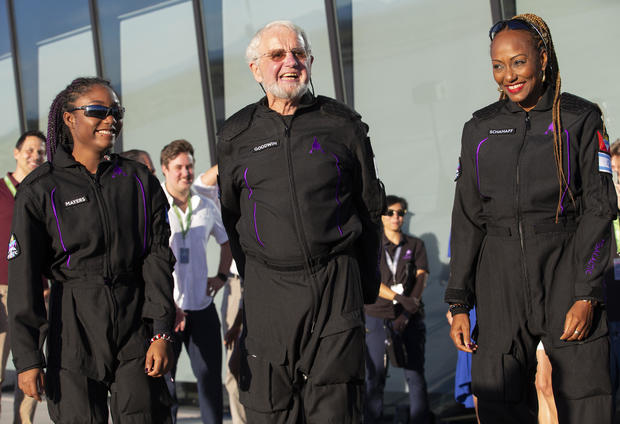
"That was by far the most awesome thing I've ever done in my life," Goodwin said after landing. "The thing that surprised me more than everything else was the beauty of the Earth from space. It is completely surreal. I've got some fast cars, but that acceleration was just unbelievable. Thank you Virgin Galactic. It's been 20 years for the wait. But it's been worth every moment of it. Thank you."
With the Unity space plane strapped to the wing of Virgin's twin-fuselage VMS Eve carrier jet, the flight got underway at about 11 a.m. EDT, taking off from Spaceport America's 12,000-foot runway in the New Mexico desert near White Sands Missile Range.
After climbing to an altitude of about 45,000 feet, Unity was released, dropping like a bomb from the carrier jet's wing. Seconds later its hybrid rocket motor ignited, propelling the ship up on a near-vertical climb out of the dense lower atmosphere.
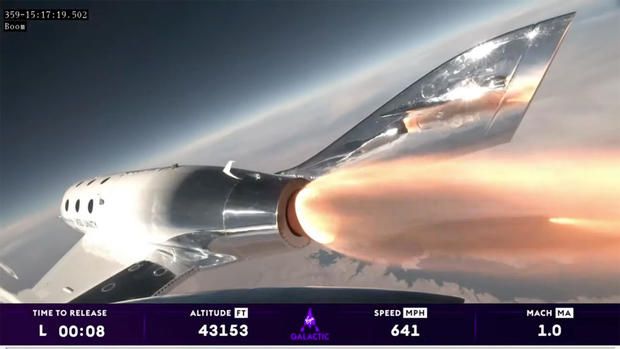
Reaching a velocity of about three times the speed of sound, the rocket motor shut down and the crew was suddenly weightless. Unity continued upward, coasting to a maximum altitude of 54.9 miles.
As they climbed, arced over the top of the trajectory and began descending, Schahaff, Mayers, Goodwin and Moses were able to unstrap and float about the cabin if they wished — the pilots remained strapped in throughout — taking in spectacular views of Earth and space.
Then, with Unity's wings "feathered," that is, swept up about 60 degrees to increase atmospheric drag and slow the descent, the spacecraft plunged back into the discernible atmosphere. The wings then were rotated back to their more traditional orientation and the pilots guided Unity, now flying as a glider, back to touchdown at Spaceport America.
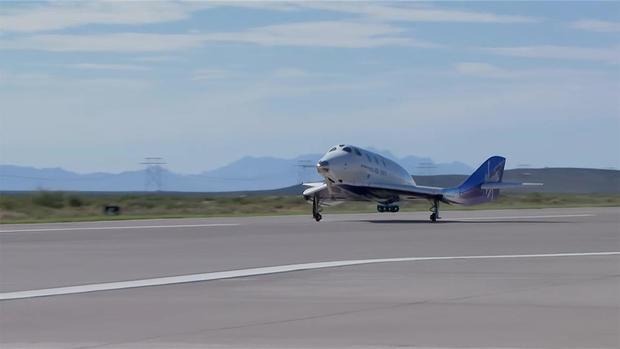
The flight was Virgin's second commercial mission, following on the heels of a flight June 29 that carried three Italian air force researchers , two Virgin pilots and a company engineer to an altitude of nearly 53 miles.
That flight was chartered by the Italian government while Thursday's flight was the first with "private astronauts." Virgin officials say some 800 applicants are on the waiting list to fly aboard the company's spaceplane.
Blue Origin, owned by Amazon-founder Jeff Bezos, has offered commercial sub-orbital flights aboard its New Shepard spacecraft since 2021, but the company is currently grounded amid work to resolve a booster problem that derailed an unpiloted research mission last year.
Thursday's flight was Virgin's seventh piloted sub-orbital mission since an initial test flight on December 13, 2018. After two more test flights, Branson and a crew of six completed the company's fourth space flight on July 11, 2021, climbing to an altitude of 53 miles.
After standing down to upgrade the Eve carrier jet, Virgin launched a fifth piloted test flight with six company employees on May 25, followed by the Italian research mission on June 29. Virgin plans to eventually ramp up to a flight per month.
- Virgin Galactic
- Richard Branson

Bill Harwood has been covering the U.S. space program full-time since 1984, first as Cape Canaveral bureau chief for United Press International and now as a consultant for CBS News.
More from CBS News

Veteran taikonaut, 2 rookies launched to Chinese space station

Astronauts confident Boeing's Starliner is finally ready for crew flights
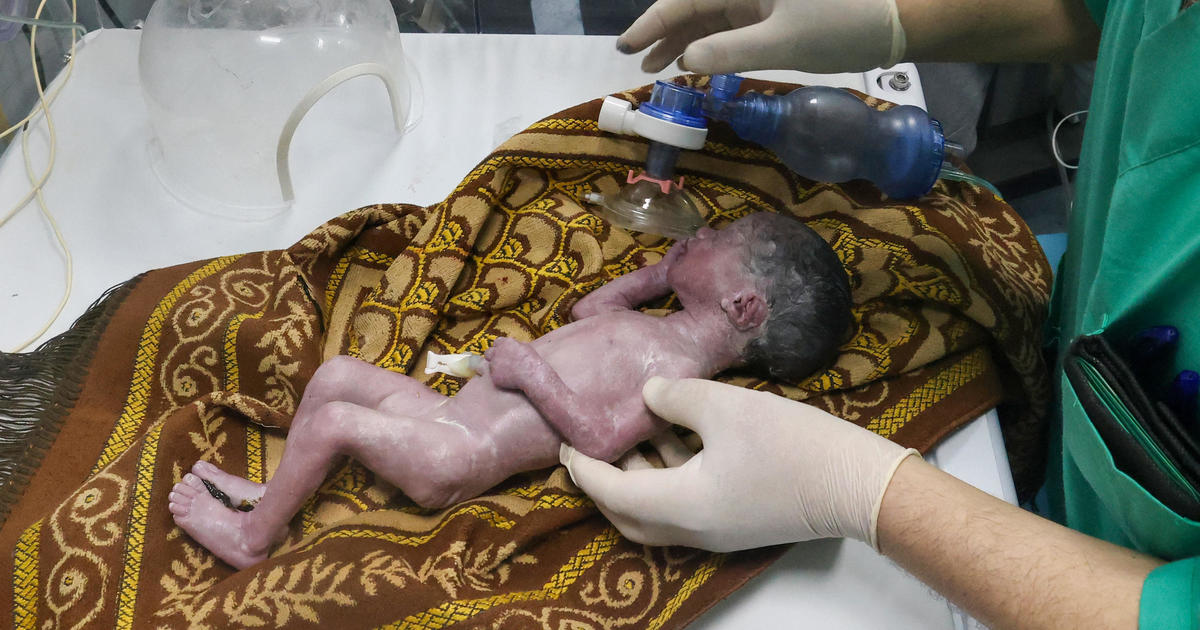
Baby girl saved from dying mother's womb dies just days later in Gaza
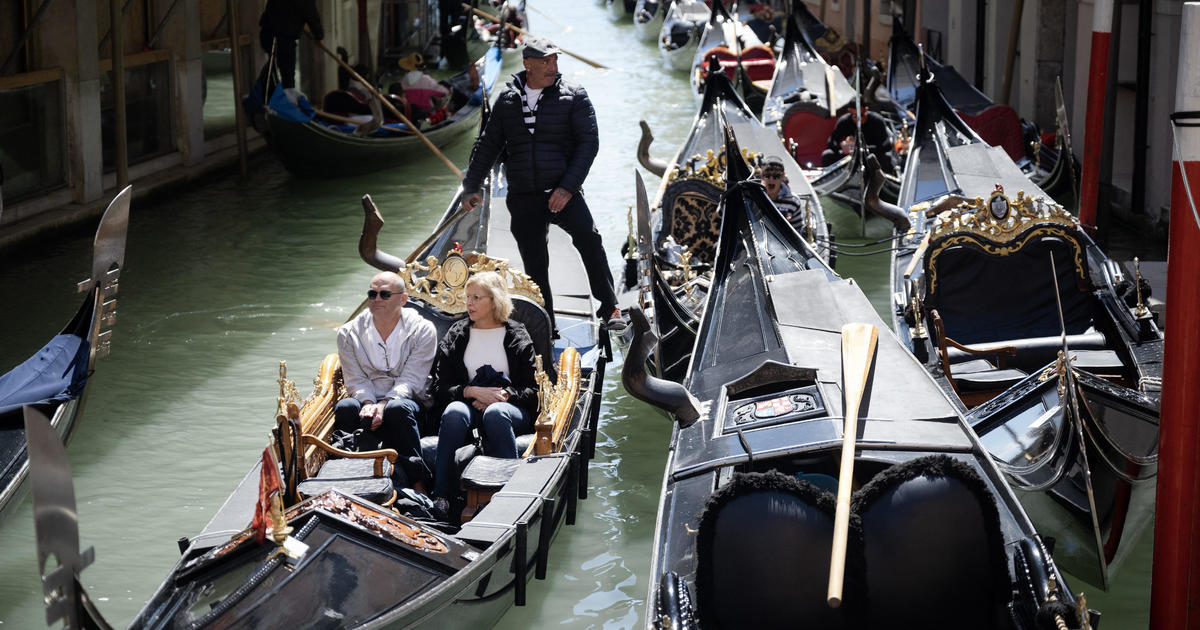
Venice becomes first city to charge a daily tourist fee
- International edition
- Australia edition
- Europe edition
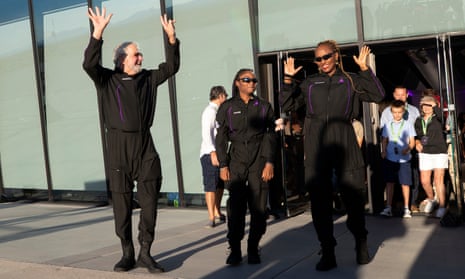
Virgin Galactic successfully flies tourists to space for first time
Six individuals were aboard VSS Unity space plane, including first mother-daughter duo to venture to space together
Virgin Galactic’s VSS Unity, the reusable rocket-powered space plane carrying the company’s first crew of tourists to space, successfully launched and landed on Thursday.
The mission, known as Galactic 02, took off shortly after 11am ET from Spaceport America in New Mexico .
Aboard the spacecraft were six individuals total – the space plane’s commander and former Nasa astronaut CJ Sturckow, the pilot Kelly Latimer, as well as Beth Moses, Virgin Galactic’s chief astronaut instructor who trained the crew before the flight.
The spacecraft also carryied three private passengers, including the health and wellness coach Keisha Schahaff and her 18-year-old daughter, Anastasia Mayers, both of whom are Antiguan.
According to Space.com, Schahaff won her seat onboard the Galactic 02 as part of a fundraising competition by Space for Humanity, a non-profit organization seeking to democratize space travel. Mayers is studying philosophy and physics at Aberdeen University in Scotland. Together, Schahaff and Mayers are the first mother-daughter duo to venture to space together.
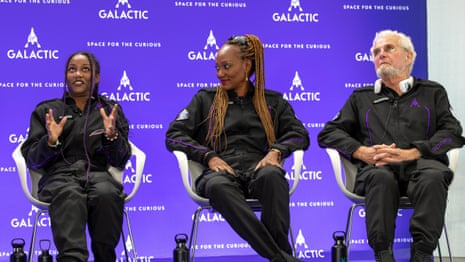
“When I was two years old, just looking up to the skies, I thought, ‘How can I get there?’ But, being from the Caribbean, I didn’t see how something like this would be possible. The fact that I am here, the first to travel to space from Antigua, shows that space really is becoming more accessible,” Schahaff said in a statement last month.
The mission also marks the most women flown in a single mission to space.
Onboard the flight was also the former Olympian Jon Goodwin, who participated in the 1972 Olympics in Munich as a canoeist. At 80 years old, Goodwin was the second passenger with Parkinson’s disease and the first Olympian to embark on a trip to space.
“When I was diagnosed with Parkinson’s in 2014, I was determined not to let it stand in the way of living life to the fullest. And now for me to go to space with Parkinson’s is completely magical,” he said in a news release. “I hope this inspires all others facing adversity and shows them that challenges don’t have to inhibit or stop them from pursuing their dreams,” Goodwin said .
Galactic 02 is a suborbital flight. However, despite VSS Unity not reaching orbit, the trajectory allows passengers to experience several minutes of weightlessness at an altitude high enough for them to see the Earth’s curvature, Space.com explains .
Following liftoff, Virgin Galactic’s carrier plane VMS Eve transported VSS Unity to an altitude of about 44,300ft. Eve then dropped Unity, which then fired its own rocket motor and ascended to suborbital space. Passengers onboard experienced approximately 3Gs.
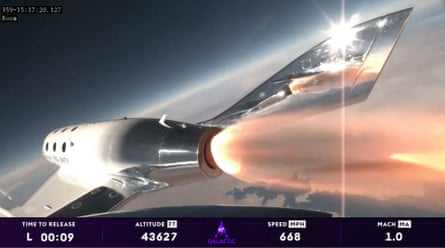
Live footage inside the spacecraft showed the passengers unstrapping themselves from their seats and peering out down to Earth through the windows as they floated throughout the spacecraft.
In a press conference after the flight, Schahaff recounted her experience, saying: “Looking at Earth was the most amazing … It was so comfortable. It really was the best ride ever. I would love to do this again.
“This experience has given me this beautiful feeling that if I can do this, I can do anything,” she added.
Mayers, who is the second-youngest person to go to space, said: “I was shocked at the things that you feel. You are so much more connected to everything than you would expect to be. You felt like a part of the team, a part of the ship, a part of the universe, a part of Earth. It was incredible and I’m still starstruck.”
To Goodwin, the experience was far more dramatic than he expected.
after newsletter promotion
“The pure acceleration, Mach 3 [2,301mph, 3,378 ft per second] in eight and a half seconds was completely surreal. The re-entry was a lot more dramatic than I imagined it would be. In fact, I would have said it was out of control if I didn’t know anything different,” he said.

“It was a completely surreal experience. But the most impressive thing was looking at Earth from space. The pure clarity was very moving, quite surreal. It was without a doubt the most exciting day of my life,” he added.
In a statement released following the flight, Sturckow said: “It is a surreal and humbling experience to have flown Unity today. The wonder and excitement of spaceflight never loses its magic.”
Latimer echoed similar sentiments, saying: “In my entire career, from the Air Force Academy to being a test pilot for Nasa, nothing tops what I have just experienced at the controls of VSS Unity. Going to space today fulfilled an ambition I’ve had since I was a child.”
The Virgin Galactic founder, Sir Richard Branson, also hailed the flight, tweeting: “Today we flew three incredible private passengers to space: Keisha Schahaff, Anastatia Mayers and Jon Goodwin. Congratulations Virgin Galactic commercial astronauts 011, 012 and 013 – welcome to the club!”
Despite Galactic 02 being Virgin Galactic’s second commercial spaceflight mission, it is the first flight to carry private customers. In June, Galactic 01 carried three crew members from the Italian air force and the National Research Council of Italy.
In July 2021, Branson traveled to space and back onboard the VSS Unity, a mission that marked the billionaire’s entry into the new era of space tourism helmed by other billionaires including the SpaceX founder, Elon Musk, and Blue Origin founder, Jeff Bezos.
According to Virgin Galactic, the company has already booked a backlog of about 800 customers. Tickets have ranged from $250,000 to $450,000.
Galactic 03, the company’s third commercial spaceflight, is planned for September.
- Virgin Galactic
Most viewed
Mountain View, CA
Mountain View
Around the Globe
Hurricane tracker.
Severe Weather
Radar & Maps
News & features, winter center, news / astronomy, ‘cabs to get into space’: how this indian startup wants to revolutionize satellite space travel.
India is pushing pioneering national initiatives, including plans to have its own space station by 2035 and to put an Indian astronaut on the moon by 2040.
By Amy Gunia, CNN
Published Apr 26, 2024 4:20 AM PDT | Updated Apr 26, 2024 4:20 AM PDT

Prime Minister Narendra Modi speaks at the launch of space infrastructure projects at Vikram Sarabhai Space Centre (VSSC), in Thiruvananthapuram, India on February 27. (Photo credit: ANI/Reuters via CNN Newsource)
(CNN) — India is one of the world’s top spacefaring nations. It is the first Asian country to reach Mars orbit, and the fourth on the planet to take a spacecraft to the moon, landing closer to the south pole, known for its cratered terrain, than anyone else had at the time.
But its private sector has played a limited role in space exploration, acting mostly as suppliers and vendors for its national space agency, the Indian Space Research Organization (ISRO).
That’s changing quickly, owing to a raft of government reforms aiming to boost private participation in the space sector. In the United States, the proliferation of private companies like Elon Musk’s SpaceX have boosted Washington’s space ambitions by driving down costs.
Now Indian homegrown startups like Skyroot Aerospace, which launched the country’s first private rocket in 2022, are leading the charge to commercialize India’s space sector and bolster its status as a space superpower.
Inside a sleek rocket hanger in the southern city of Hyderabad, the company is preparing for lift-off of the seven-story tall Vikram-1 rocket, which will take India’s first privately launched satellites into orbit.
“That’ll be a major milestone for us,” Pawan Chandana, a former ISRO scientist who co-founded Skyroot Aerospace in 2018, told CNN. “Very few companies globally are able to make it to orbit yet.”
India is pushing pioneering national initiatives, including plans to have its own space station by 2035 and to put an Indian astronaut on the moon by 2040.
Meanwhile, Prime Minister Narendra Modi, who is currently running for his third consecutive term, has made a major push to commercialize space activity in recent years, including allowing private enterprise to take part and easing approvals for foreign investment into the space sector.
Small satellites, big opportunity
Companies around the world are catapulting thousands of satellites into low Earth orbit (LEO), which extends to an altitude of about 2,000 kilometers (1,200 miles), to form mega-constellations: groups of small satellites that work together to beam broadband Internet to terrestrial users.
According to analytics firm BryceTech, 96% of spacecraft launched in 2022 were small satellites, up from 61% in 2013.
That’s driving exponential growth. The global space economy was worth $630 billion in 2023, according to a report by McKinsey & Company and the World Economic Forum, and it could grow to $1.8 trillion by 2035.
It’s the small satellite market that Skyroot wants to capture, with plans to offer customized launches for satellites under 500 kilograms (1,100 pounds).
Organizations’ satellites often piggyback onto “rideshare” missions. Last year, for example, one SpaceX journey — powered by its Falcon 9 rocket, which can carry 22,000 kilograms (48,500 pounds) into LEO — launched 51 small satellites into orbit for multiple companies.
But there’s often a waiting period to hitch a ride, and satellites can only go where the rocket is heading. That may be disadvantageous for a satellite that wants to reach a particular orbit, to observe a certain part of the planet.
The model does provides advantages. SpaceX says the cost of getting a 500-kilogram (1,100 pound) payload into LEO is about $6,000 per kilogram.
“It’s really very, very competitive what SpaceX is now offering,” says Susmita Mohanty, director general of Indian think-tank Spaceport Sarabhai.
Skyroot wants to offer dedicated launches for $20,000 per kilogram, which is much more expensive than SpaceX’s less bespoke service. (Chandana says that mass production and better technology may enable further cost reductions).
Chandana compares SpaceX’s ridesharing missions as “a train to go to space” and Skyroot’s operations as “cabs to get into space, where we take satellites to their customized locations.”
He adds: “We don’t directly compete with SpaceX, because SpaceX is into bigger vehicles and satellites … and what we are into is customized launch solutions.”
Once prices drop, there will be more interest in “people wanting to choose dedicated launches without compromising on going for a rideshare mission,” he said.
Customized launches might be useful for those who want to send smaller payloads aiming to reach “a diverse amount of orbits” that might not be possible to get to by ridesharing, says Kari Bingen , director of the Aerospace Security Project at the Center for Strategic and International Studies, a think-tank based in the US.
That could be useful for commercial companies, academic institutions or governments that are willing to pay the price, she adds.
Chandana is optimistic he can make it more affordable, noting the “frugality in the DNA” of India’s space program. (The country’s Mars orbiter budget was just $74 million. Modi has pointed out that it cost less than the Hollywood sci-fi thriller “Gravity.”)
Chandana adds that the company aims to build a reusable rocket eventually, a capability which has helped SpaceX reduce launch costs.
Hurdles to clear
India is now home to almost 200 space startups, up from just one in 2014, according to a report published by Deloitte in 2023. Over the same period, private investment into those companies topped $200 million.
Skyroot has already raised $95 million, with backers like Singapore sovereign wealth fundâ¯GIC. That makes it India’s most-funded space startup, according to data platform Tracxn .
But the company has work to do to reach profitability. It needs to demonstrate that it can consistently reach orbit, before interest “will turn into contracts, which will help us scale,” says Chandana. Yet spots on Vikram-1 are fully booked, with a mix of domestic and international clients.
As Indian space startups mature over the coming years, he expects the government to become a customer, enabling further growth. Many private space companies source income from governments, including Space X, which has raked in billions of dollars from US government contracts.
India’s government allocated just under $1.6 billion to develop its space prorgram in its interim 2024 budget . By comparison, NASA received $24.9 billion for 2024.
“Unless and until the government backs up the reforms with significant funding coming from India itself, it will be difficult for us to rival the development of the US market or the Chinese market,” says Mohanty.
She adds that for Indian startups to play a meaningful role in the global marketplace, “they need to go beyond servicing our own space agency’s domestic mandate and start bidding for contracts.”
Chandana sounds up for the challenge. “We want to become globally [one of the] top three launch companies,” he says. “My fascination for rockets has become an obsession.”
Read more about space exploration:

The-CNN-Wire™ & © 2024 Cable News Network, Inc., a Warner Bros. Discovery Company. All rights reserved.
Weather News

LIVE: Cleanup begins, severe weather risk to linger through weekend

How to recognize a 'radar-confirmed tornado'
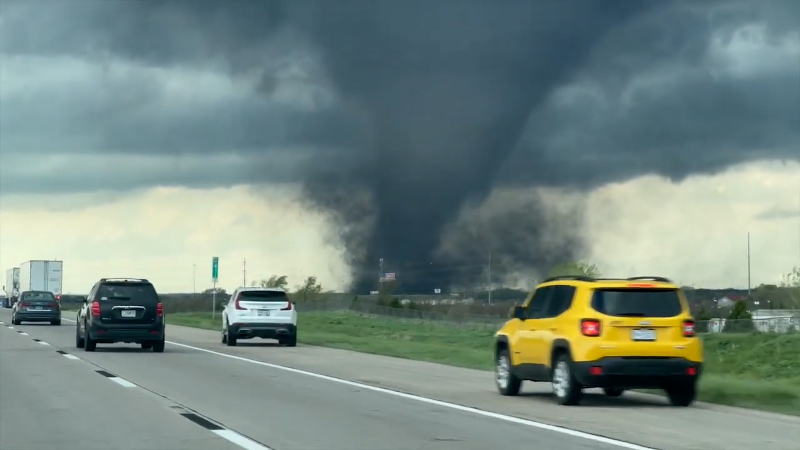
'That's a strong tornado:' Tornado rips across I-80 in Nebraska
Top Stories
Trending Today
Accuweather early, accuweather prime, forecast victories.
LATEST ENTRY
Cleanup begins after tornadoes, severe weather risk to linger through the weekend

Central states preparing for another round of volatile thunderstorms
10 hours ago

This map may save lives when there's a tornado threat

Weather Forecasts
Spring fever: Northeast cities chasing 90-degree highs
11 hours ago

First-ever photograph of a tornado from 140 years ago likely a fake

Featured Stories
10 types of tornadoes that occur in the US

Overrun Japanese town erects barrier to block photos of Mount Fuji

Indian voters battle extreme temperatures amid intense heat wave

A lake in Mexico’s ‘magical town’ is disappearing

More than 100 prisoners flee after rainfall destroys prison in Nigeria

We have updated our Privacy Policy and Cookie Policy .
Get AccuWeather alerts as they happen with our browser notifications.
Notifications Enabled
Thanks! We’ll keep you informed.
Inside NASA's 5-month fight to save the Voyager 1 mission in interstellar space

After working for five months to re-establish communication with the farthest-flung human-made object in existence, NASA announced this week that the Voyager 1 probe had finally phoned home.
For the engineers and scientists who work on NASA’s longest-operating mission in space, it was a moment of joy and intense relief.
“That Saturday morning, we all came in, we’re sitting around boxes of doughnuts and waiting for the data to come back from Voyager,” said Linda Spilker, the project scientist for the Voyager 1 mission at NASA’s Jet Propulsion Laboratory in Pasadena, California. “We knew exactly what time it was going to happen, and it got really quiet and everybody just sat there and they’re looking at the screen.”
When at long last the spacecraft returned the agency’s call, Spilker said the room erupted in celebration.
“There were cheers, people raising their hands,” she said. “And a sense of relief, too — that OK, after all this hard work and going from barely being able to have a signal coming from Voyager to being in communication again, that was a tremendous relief and a great feeling.”

The problem with Voyager 1 was first detected in November . At the time, NASA said it was still in contact with the spacecraft and could see that it was receiving signals from Earth. But what was being relayed back to mission controllers — including science data and information about the health of the probe and its various systems — was garbled and unreadable.
That kicked off a monthslong push to identify what had gone wrong and try to save the Voyager 1 mission.
Spilker said she and her colleagues stayed hopeful and optimistic, but the team faced enormous challenges. For one, engineers were trying to troubleshoot a spacecraft traveling in interstellar space , more than 15 billion miles away — the ultimate long-distance call.
“With Voyager 1, it takes 22 1/2 hours to get the signal up and 22 1/2 hours to get the signal back, so we’d get the commands ready, send them up, and then like two days later, you’d get the answer if it had worked or not,” Spilker said.

The team eventually determined that the issue stemmed from one of the spacecraft’s three onboard computers. Spilker said a hardware failure, perhaps as a result of age or because it was hit by radiation, likely messed up a small section of code in the memory of the computer. The glitch meant Voyager 1 was unable to send coherent updates about its health and science observations.
NASA engineers determined that they would not be able to repair the chip where the mangled software is stored. And the bad code was also too large for Voyager 1's computer to store both it and any newly uploaded instructions. Because the technology aboard Voyager 1 dates back to the 1960s and 1970s, the computer’s memory pales in comparison to any modern smartphone. Spilker said it’s roughly equivalent to the amount of memory in an electronic car key.
The team found a workaround, however: They could divide up the code into smaller parts and store them in different areas of the computer’s memory. Then, they could reprogram the section that needed fixing while ensuring that the entire system still worked cohesively.
That was a feat, because the longevity of the Voyager mission means there are no working test beds or simulators here on Earth to test the new bits of code before they are sent to the spacecraft.
“There were three different people looking through line by line of the patch of the code we were going to send up, looking for anything that they had missed,” Spilker said. “And so it was sort of an eyes-only check of the software that we sent up.”
The hard work paid off.
NASA reported the happy development Monday, writing in a post on X : “Sounding a little more like yourself, #Voyager1.” The spacecraft’s own social media account responded , saying, “Hi, it’s me.”
So far, the team has determined that Voyager 1 is healthy and operating normally. Spilker said the probe’s scientific instruments are on and appear to be working, but it will take some time for Voyager 1 to resume sending back science data.
Voyager 1 and its twin, the Voyager 2 probe, each launched in 1977 on missions to study the outer solar system. As it sped through the cosmos, Voyager 1 flew by Jupiter and Saturn, studying the planets’ moons up close and snapping images along the way.
Voyager 2, which is 12.6 billion miles away, had close encounters with Jupiter, Saturn, Uranus and Neptune and continues to operate as normal.
In 2012, Voyager 1 ventured beyond the solar system , becoming the first human-made object to enter interstellar space, or the space between stars. Voyager 2 followed suit in 2018.
Spilker, who first began working on the Voyager missions when she graduated college in 1977, said the missions could last into the 2030s. Eventually, though, the probes will run out of power or their components will simply be too old to continue operating.
Spilker said it will be tough to finally close out the missions someday, but Voyager 1 and 2 will live on as “our silent ambassadors.”
Both probes carry time capsules with them — messages on gold-plated copper disks that are collectively known as The Golden Record . The disks contain images and sounds that represent life on Earth and humanity’s culture, including snippets of music, animal sounds, laughter and recorded greetings in different languages. The idea is for the probes to carry the messages until they are possibly found by spacefarers in the distant future.
“Maybe in 40,000 years or so, they will be getting relatively close to another star,” Spilker said, “and they could be found at that point.”
Denise Chow is a reporter for NBC News Science focused on general science and climate change.
- Skip to main content
- Keyboard shortcuts for audio player
NASA's Voyager 1 spacecraft, launched in 1977, is finally 'phoning home' again
The space probe contacted ground control for the first time in five months with status updates on its engineering systems. A month ago a NASA team discovered corrupted code caused a lapse in contact.
(SOUNDBITE OF MUSIC)
MICHEL MARTIN, HOST:
Good morning, I'm Michel Martin. NASA's Voyager 1 spacecraft, originally launched in 1977, is finally phoning home again. The space explorer contacted ground control for the first time in five months with status updates on its engineering systems. The breakthrough comes a month after the space probe's operating team discovered corrupted code was causing the lapse in contact. The team hopes Voyager 1 can start sending scientific data again in the next few weeks.
MARTIN: It's MORNING EDITION.
Copyright © 2024 NPR. All rights reserved. Visit our website terms of use and permissions pages at www.npr.org for further information.
NPR transcripts are created on a rush deadline by an NPR contractor. This text may not be in its final form and may be updated or revised in the future. Accuracy and availability may vary. The authoritative record of NPR’s programming is the audio record.

Man who hoped to be first Black astronaut in 1960s finally heading to space
I n 1961, Ed Dwight hoped to become the first Black astronaut in space. But he never made it. Now, at 90 years old, Dwight will get the chance to finally experience space onboard Blue Origin's upcoming mission into Earth's atmosphere.
Dwight was selected by President John F. Kennedy in 1961 to enter an Air Force training program known as the path to NASA's Astronaut Corps.
When he got the letter in 1961 offering him the opportunity to be the first Black astronaut, "I thought these dudes were crazy," Dwight told national correspondent Jericka Duncan in 2022.
After completing the program in 1963, the Air Force recommended he join the corps, but he wasn't selected and entered private life in 1966.
Dwight said he felt discrimination among his peers during the training.
"So, all these White folks that I'm dealing with, I mean, my peers, the other guys that were astronaut candidates and the leadership was just horrified at the idea of my coming down to Edwards and the president appointing me to the position," Dwight said.
His dream of going to space fell by the wayside for more than 60 years. But Dwight has been selected as one of the six civilians to travel to the edge of space on the next Blue Origin flight in June.
Blue Origin, a space exploration company founded by Jeff Bezos, has sent 22 successful commercial flights into the atmosphere. Some of the famous passengers include Bezos himself, who was on the historic first flight, Michael Strahan and William Shatner.
During the first commercial flight, aviation pioneer Wally Funk became the oldest person to travel to space at age 82. At 90 years old, Shatner took the title of the oldest person in space.
Now, Dwight will have him tied.
After his flight training and subsequent leave from the Air Force, Dwight dedicated his life to creating sculptures that depict iconic figures in Black history. More than 130 pieces of his work have been exhibited in museums and installed in public spaces.
His seat on the Blue Origin flight – which is believed to cost $250,000 – is sponsored by the nonprofit Space for Humanity , which helps send citizens to space. They also sponsored Katya Echazarreta, 26, an electrical engineer originally from Guadalajara, Mexico, who went on Blue Origin's June 2022 mission, becoming the first Mexican-born American woman and one of the youngest women ever to fly to space.
The space trip takes the civilians about 62 miles away from Earth and into the atmosphere for a few minutes of weightlessness and a view of space and Earth.
The other five people on the upcoming Blue Origin flight are venture capitalist Mason Angel, French brewery founder Sylvain Chiron, software engineer Kenneth L. Hess, retired CPA Carol Schaller and pilot and aviator Gopi Thotakura.


COMMENTS
CNN —. On April 30, 2001, US millionaire Dennis Tito arrived at the International Space Station (ISS) via a Russian Soyuz rocket, becoming the world's first space tourist. For Tito, then 60 ...
Dennis Anthony Tito (born August 8, 1940) is an American engineer and entrepreneur.In mid-2001, he became the first space tourist to fund his own trip into space, when he spent nearly eight days in orbit as a crew member of ISS EP-1, a visiting mission to the International Space Station.This mission was launched by the spacecraft Soyuz TM-32, and was landed by Soyuz TM-31.
American businessman Dennis Tito, the world's first orbital space tourist, is seen training for his historic 2001 flight to the International Space Station. Tito launched in April 2001 aboard a ...
The first space tourist, Dennis Tito (left) aboard the ISS Space tourist Mark Shuttleworth. ... However, their equipment was never launched and is to be converted into an educational exhibit. The Golden Spike Company was an American space transport startup active from 2010 to 2013.
The worlds first space tourist Dennis Tito (center) flies into the International Space Station as Russian Talgat Musabayev (right) looks on and the station's Russian commander Yuri Usache welcomes ...
Dennis Tito, first "space tourist," teams up with SpaceX to return to space 04:04. Dennis Tito, an 82-year-old aerospace engineer-turned-financial analyst who paid Russia $20 million for a trip to ...
More than 20 years ago, Dennis Tito, the first "space tourist" (also known as "spaceflight participant"), flew to the International Space Station aboard a Soyuz spacecraft for a six-day stay. Tito donated the Sokol pressure suit he wore in space to the Museum in 2003. Since his flight, only six other individuals scored self-funded ...
On April 28, 2001, American entrepreneur Dennis Tito became the world's first space tourist when he soared into orbit aboard a Russian Soyuz spacecraft bound for the International Space Station ...
First space tourist Dennis Tito: 'I was euphoric'. Businessman Dennis Tito paid $20 million to fly with the Russians to the International Space Station in 2001. He was on board for eight days and ...
It currently has two tourist launches planned. The first is scheduled for as early as September 2021, funded by billionaire businessman Jared Isaacman. The other trip, planned for 2022, is being ...
The world's first space tourist plans for a return engagement. ... The Starship is a 50 m (164 ft.) tall stainless steel spacecraft that launches atop SpaceX's 69 m (226 ft.) Super Heavy booster
The world's first space tourist has signed up to spin around the moon aboard Elon Musk's Starship. For Dennis Tito, it's a chance to relive the joy of his trip 21 years ago to the International Space Station. ... But the Russian Space Agency needed the cash and, with the help of U.S.-based Space Adventures, launched a string of wealthy ...
The first space tourist left Earth 20 years ago aboard a Russian rocket. Now, private companies like Jeff Bezos' Blue Origin are offering trips to the stars for those who can pay.
TRUTH OR CONSEQUENCES, N.M. (AP) — Virgin Galactic rocketed to the edge of space with its first tourists Thursday, a former British Olympian who bought his ticket 18 years ago and a mother-daughter duo from the Caribbean. The space plane glided back to a runway landing at Spaceport America in the New Mexico desert, after a brief flight that ...
CNN —. Virgin Galactic — the space tourism company founded by British billionaire Richard Branson — finally launched its first space tourists to the edge of the cosmos, a major step toward ...
Virgin Galactic launched its first tourist passengers into the weightlessness of space Thursday, the culmination of a nearly two-decade commercial pursuit, the company said. Issued on: 10/08/2023 ...
Virgin Galactic has launched its first tourist passengers — Olympian Jon Goodwin and mother-daughter duo Keisha Schahaff and Anastatia Mayers — to the edge of space and back. The flight ...
The engineer turned financial analyst was the first private individual to pay for a trip to space on Russia's Soyuz TM-32 mission in 2001, when he spent nearly eight days aboard the ISS.
Watch: Virgin Galactic launches first space tourism flight 19:56. Richard Branson's Virgin Galactic picked up the pace in the space tourism marketplace with the launch Thursday of its VSS Unity ...
Virgin Galactic's VSS Unity, the reusable rocket-powered space plane carrying the company's first crew of tourists to space, successfully launched and landed on Thursday. The mission, known as ...
Homegrown startups, Skyroot Aerospace, which launched the country's first private rocket in 2022, is leading the charge to commercialize India's space sector and bolster its status as a space ...
Last year, for example, one SpaceX journey — powered by its Falcon 9 rocket, which can carry 22,000 kilograms (48,500 pounds) into LEO — launched 51 small satellites into orbit for multiple ...
The mission is China's first manned mission to the space station this year, the third since the space station entered application and development phase, China's 32nd manned flight into space, and ...
In 2012, Voyager 1 ventured beyond the solar system, becoming the first human-made object to enter interstellar space, or the space between stars. Voyager 2 followed suit in 2018. Voyager 2 ...
The space probe contacted ground control for the first time in five months with status updates on its engineering systems. A month ago a NASA team discovered corrupted code caused a lapse in contact.
During the first commercial flight, aviation pioneer Wally Funk became the oldest person to travel to space at age 82. At 90 years old, Shatner took the title of the oldest person in space.. Now ...